 |
Tourists' places of interest |
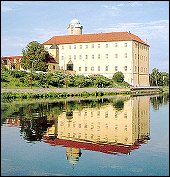
Podebrady ChΓteau |
Podebrady ChΓteau, originally a castle, was perhaps founded in the first half of the 12th century. At that time, after the fall of the powerful Slavnik principality and the extinction of the Vrsovci, unknown owners of the Podebrady territory built a fortified seat on a cretaceous marly limestone rock overlooking the River Elbe. When Podebrady was ranked among the royal estates as an escheat during the reign of Premysl Otakar II a stone water castle was built here at which the sovereign and his whole court resided from time to time. The castle was one of a number of strategic places on the Elbe whose purpose was to defend Prague against enemy attacks from the east and the north-east. In the 14th century the Podebrady estate fell into the hands of impor- tant Moravian noblemen - the lords of Kunstat, who improved the defence ability of their seat to a considerable extent. During their ownership the castle was newly rebuilt and perfectly fortified during the l4th and in the early l5th century. Apart from other things, its already existing moats were widened, being supplied with water from a swelling weir. |
|
The next, Renaissance reconstruction of the castle was carried out during the reign of the Emperor Ferdinand I in the latter half of the 16th century. The work was headed by the Italian architect G. B. Aos- talli de Sala, who converted the castle into a comfortable summer hunting seat. This reconstruction, similarly as the one which pre- ceded it, eliminated the results of Maria Theresa's previous recon- struction. The chΓteau did not lose its new appearance even when in the possession of its last private owners, who from 1885 to 1912 were Count A. F. Hohenlohe of Schillingsfⁿrst and his wife Chariclea nΘe Ypsillanti. The present appearance of the chΓteau is thus the result of several thorough reconstructions - from a water castle, a medieval fortress and a Renaissance royal seat up to a Late Baroque building intended to fulfil military purposes during the reign of Josef II. Only two interiors in the whole chΓteau are now accessible to the public, namely the restored medieval chapel and the neighbouring so-called family hall of King Jiri (George of Podebrady). |
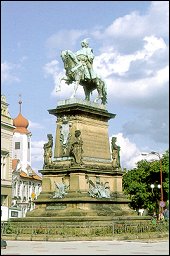
The equestrian statue of King George |
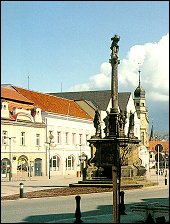
The Marian column |
The equestrian statue of King George of Podebrady, the work of Bohuslav Schnirch, ranks among the most outstanding Czech monumental sculptures of the l9th century. It originated in a wholly unique way, for it was hammered from copper plates fixed on a steel bearing structure. Originally installed at the Jubilee and Ethnographical Exhibition in Prague, the statue was solemnly unveiled at Podebrady in 1896. The Marian column was raised in the square as a monument to the plague which raged in the town in 1714. It dates in 1765 and is most likely the work of the Podebrady Baroque sculptor Josef Bergman. On the top of the column there is a statue The Mother of God and the column is surrounded by four figures of saints (St. Wenceslas, St. Adalbert, St. Procopius and St. Florian). |
|
The Old Town Hall (now the Municipal Popular Library) was built to replace the burned-out Town Hall building which once stood on the site of the Zalozna Hotel. In 1775 the town purchased a burgher's house of the l6th century for the purpose and in 1814 had a tower added to it. The building has remained practically unchanged since that time. The bell in the tower summoned the councillors to council meetings and later served to inform the town's inhabitants of the occurrence of a fire. It served Town Hall purposes until World War II. The memorial tablet situated on the faτade of the building brings to mind the revivalist poet and dramatist Frantisek Turinsky, who was born here. The tablet is the work of the sculptor Bohuslav Schnirch. |
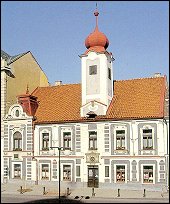
The old town hall |
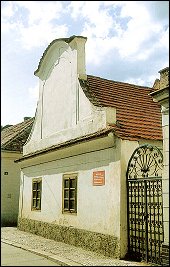
The hospital |
The Hospital. This ancient ground-floor building at the end of the lane called Na dlazdeni, standing next to the museum, was built in 1444 and maintained by the endowment of Kunhuta of Sternberk - the first wife of King George of Podebrady - as a hospital. Poverty-stricken old women with the duty of uttering daily prayers for the health of the Hapsburg family still lived here in the 17th century. The building gained its present appearance in the first half of the 18th century. It now serves the purposes of the museum. The Miners' Church. This church stands on the site where ten leaders of the uprising of Kutna Hora miners were unjustly executed in 1496. In order to commemorate this tragic event a wooden church was erected here already in 1516, being replaced with a stone building in the mid-l7th century. The present Neo-Gothic appearance of the church is the result of its reconstruction in 1896. The sculptures on its faτade are the work of the sculptor Bohuslav Schnirch. |
|
According to a legend drops of blood fell from an oak tree during the execution and from then on it produced acorns in the form of a headless body. The oak tree grew here until 1777 and some of its acorns are still deposited in the Podebrady museum. Near the church we can see a well - a reminder of a no longer existing spring of ferrugineuous water (popularly called bloody water). Jan Amos Komensky (Comenius) also made mention of its discovery. From 1722 until the founding of the Podebrady carbonic baths in 1908 the spring in 1908 the spring was used in small baths with several cabins built here. Beyond the miners' church begins an enclosure, founded four hundred years ago by the Emperor Ferdinand I. In the late l9th century attempts were made to acclimatize ostriches, kangaroos, antelopes and other exotic animals here. |
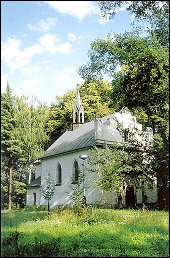
The Miners' Church |
Home page ò
History ò
Tourists' places of interest
webmaster: Ceska vydavatelska pro internet, s. r. o. /webhouse.cz/